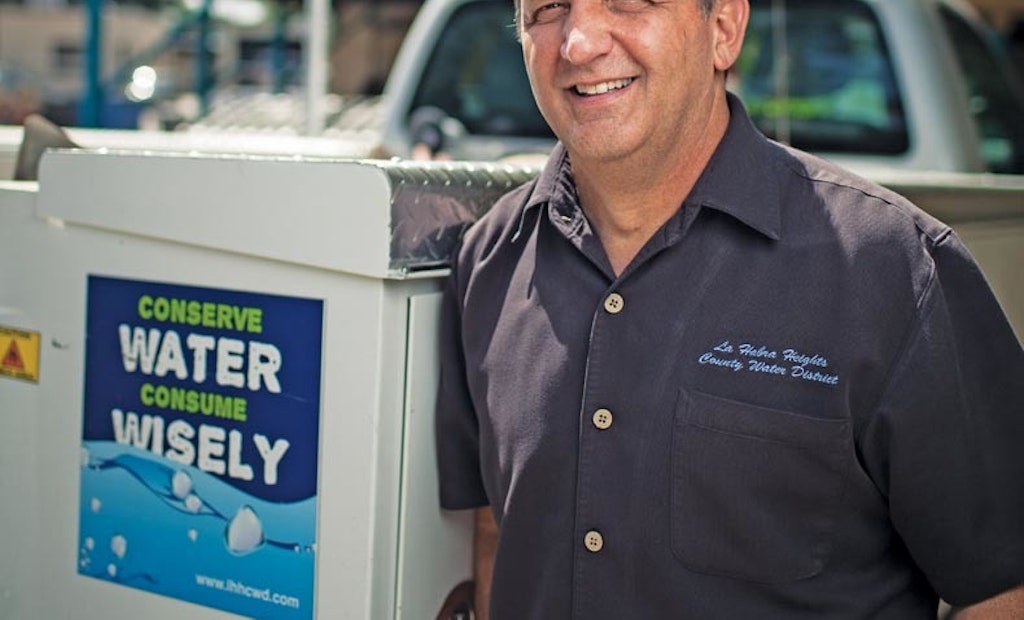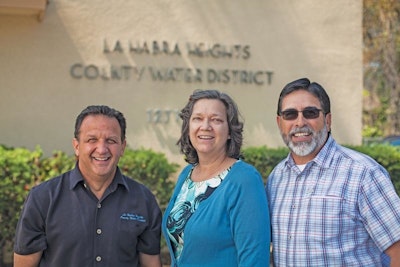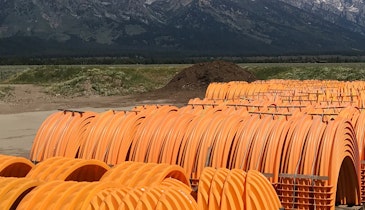
Interested in Infrastructure?
Get Infrastructure articles, news and videos right in your inbox! Sign up now.
Infrastructure + Get AlertsCalifornia’s La Habra Heights County Water District boasts a high-quality water source, a young water system and an enviable leak record. However, the district refuses to rest on its success. It’s ramping up on maintenance and inspection and developing new sources of water, while taking some unique approaches to encouraging water conservation.
The district is located 25 miles east of Los Angeles and includes most of the City of La Habra Heights and small portions of the City of Whittier and unincorporated Los Angeles County. The population of the district hovers around 5,500. Area residents pride themselves on self-sufficiency. Volunteer firefighters assist the La Habra Heights Fire Department, private companies haul trash and most of the town relies on septic tanks. However, delivering freshwater to citizens is a sacred civic responsibility.
Rising from the ranks
Michael Gualtieri is general manager of the LHHCWD. He’s been with the district since 1982 when he started as a utility worker.
“My father worked here before me, and I actually replaced him when he became sick,” says Gualtieri. “I started at the bottom and worked my way through serviceman to superintendent to general manager in 2002.”
The water system is the direct descendent of the La Habra Heights Mutual Water Company, a privately owned water utility formed in 1919 with town residents as stockholders.
“By the mid-1970s the system was rated the second- or third-worst in California, and they didn’t have the money to do the necessary repairs,” says Gualtieri.
The community voted for the company to become a special water district under the California Water Code on Nov. 2, 1976, with ratepayers funding capital projects and operations. However, system improvements didn’t occur overnight.
“When I started here in 1982, we averaged three leaks per day,” Gualtieri says. “Whenever we had downtime we would walk down the waterlines to tighten the bands that had been placed around the pipes to keep them from leaking. However, in three to four years we ramped up construction and switched to mostly new piping.”
A high-quality source
Local water is supplied by three wells located in Judson Well Field near the San Gabriel River in unincorporated Los Angeles County about 8 miles outside the city. Additional water is imported from the Metropolitan Water District of Southern California.
The district works cooperatively with its neighbors and supplies some groundwater from its wells to the Rowland and Orchard Dale water districts.
The LHHCWD is divided into two zones, with two pump stations delivering water to the lower zone and two additional stations delivering water to the upper. Some imported water is delivered by a separate pump station. Seven reservoirs store water until it’s needed.
“The water is of such high quality that we require only minimal treatment, with a small automated plant adding sodium hypochlorite,” says Gualtieri. “It’s an efficient gravity-fed system, and there aren’t any major challenges associated with it — except for the challenge of paying for all of the electricity required to run the pumps. It’s hilly terrain and we need to move the water to the reservoirs, as high as 1,150 feet in the north central part of the district.”
The district operates seven pressure-reducing stations — two major and five minor — although overall distribution pressure remains fairly high. System pressure averages between 100 and 110 psi, with some hot spots still ranging as high as 200 psi as the system is fine-tuned. In other parts of the system, pressure and volume have been increased at hydrants to exceed the requirements of the local fire department.
The current distribution system is composed of 60 miles of pipe ranging in diameter from 4 to 36 inches. Almost 90 percent of the pipe is constructed of asbestos cement (AC). About 10 percent is ductile iron, which was specified as the replacement pipe of choice from the early-1990s on. The system also contains traces of cast iron, steel and polyvinyl chloride.
“Our oldest pipe is now represented by a few sections from the 1930s, but the overall system is in great shape,” says Gualtieri. “We now probably average no more than about one leak per month, and our overall system water loss is between 5 and 7 percent, which is pretty damn good.”
Pipe displacement causes leaks
For La Habra Heights, the two primary causes of leaks are ground movement from ground fault shifts and water pipes displaced by the growth of tree roots. The pipes recording the highest pressure are often the ones that show the earliest signs of leaking. Pipes are buried between 3 and 15 feet, depending on the elevation required to maintain gravity flow.
“We’re a rural community without curbs and sidewalks,” Gualtieri says. “It’s a double-edged sword. When people plant trees along the road, water pipes are more at risk of getting bound up by tree roots than if they were planted behind the sidewalks. On the other hand, when there is a problem with the pipes, we don’t have to break through concrete to repair them.”
Another advantage to minimal paving: Water leaking into the arid soil quickly makes its way to the surface, allowing workers to more easily identify leaks.
“You can see the water reaching the surface on a walk-by,” Gualtieri says. “When a leak is identified, we use an acoustic leak detector from Goldak to pinpoint the leak and repair it. We conduct a visual inspection of all of the pipes every two years and also check the piping as we manually read the meters. The system is in good shape, and we want to keep it that way at a reasonable price to customers.”
In-house crews perform clamp repairs on any pipe buried 5 feet or less beneath the surface, excavating with a Case backhoe. Clamps are sourced from a number of suppliers including Smith-Blair or Romac Industries. A nearby contractor handles projects involving deeper excavations.
A mature customer base
“We also put in new services, but the population remains very stable,” Gualtieri says. “According to city code and the minimum lot size, there are only 100 potential lots that could be developed, and some of those are located on a hillside, so adding a new service isn’t something we do every day. It’s all residential with a golf course as the only business. Without new development we have no development fees funding new infrastructure, and everything we do has to be covered by the existing customer base.”
The district has employed trenchless technologies, including 3 miles of 28-inch cured-in-place pipe lining installed in the 1980s. Pipe bursting is still employed to draw copper service lines through old Orangeburg pipe.
La Habra Heights has looked at GIS mapping the system, but the district hasn’t been satisfied with the consistency of initial results.
“This is very hilly terrain, and it’s not always easy to get a clear link to the satellite,” Gualtieri says. “We’ll keep looking at it as the technology improves.”
Developing new water sources
The district is currently at work rehabilitating its Well No. 9, which had been deactivated, and looking to supplement its supplies with other wells. Its Well No. 8 is also on call for replacement in the next five to 10 years.
“In the future, we hope to meet our entire water demand using new wells to extract groundwater from the Judson Well Field,” Gualtieri says.
As the water district looks to the future, so do the employees who serve it. Like Gualtieri, many have been employed here for 20 years or more, with some veterans logging more than 30.
“I always tell applicants that they won’t get rich working for us,” he says. “However, if they take care of the water system, we’ll take care of them, and they’ll always be able to support their families while performing rewarding work.”











